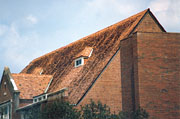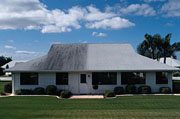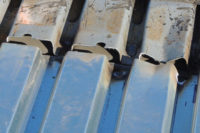
At first this roofing problem doesn't seem like one that would involve a roofing contractor. Black streaks that form on asphalt shingles a few years after installation certainly look bad, but they don't necessarily harm the roof, do they? Well, only if your customer paid extra for the appearance and durability of 40-year laminated shingles that now look dirty. Or when they pay to have someone pressure clean it every few years, a process that can void warranties and wash off excessive amounts of the protective granules.
Algae and other microscopic growths on the roofs are an age-old problem, but the solution is on the mind of both roofing contractors and homeowners. The usage of copper as the prime hindrance to algae growth is picking up speed and picking up clients for the alert contractor who can increase sales and charge a small premium for a growing need.
"We want to give an edge to the contractors," says Tim Worms, marketing manager for the Industrial Mineral Products Division at 3M. The company provides copper encapsulated granules that deter algae growth. "Algae doesn't discriminate on roof type. We're looking at algae-resistant solutions for all types."

Up and Dirty
The problem of bacterial and other microscopic growth has been a concern for a number of years. While the owners of some venerable buildings in Europe actually like the colorful display of lichen or moss on their clay tiles, those in the United States are more particular. The fungus-resistant shingles introduced in the mid 1980s utilized zinc to arrest any unwanted growth. While still used-some companies offer zinc strips to be installed at the ridge-copper is the agent offered by 3M, supplier of roofing granules to nearly every shingle manufacturer in the United States. For most roofs, algae (Gloeocapsa magma is the scientific term.) is the problem, since it forms a black coating to protect itself against ultraviolet rays.Although the company had related patents dating back to the 1960s, the Algae Block System wasn't introduced until the early 1990s. Beginning last year, it carries the company's Scotchgard™ name to take advantage of the brand's awareness and reputation with consumers. 3M has tested the product on roofs in Tampa and test decks in Houston for decades to ensure longevity of the product; there's a newer test site in Portland. It has recently doubled its warranty length from 10 to 20 years for the Scotchgard Algae Resistant System.
"We put up test roofs and would monitor the variations of different products. Our testing had shown our copper granules were lasting a lot longer than the 10-year warranty period," says Worms, adding that the company scientists like to be absolutely sure about their claims. "They said 20 years shouldn't be a problem. We've gone to 20 years because we have the research that says we can."
According to Keith Kennedy, product and technical services manager for the Industrial Mineral Products Division at 3M, copper oxide presented the most effective and durable agent to combat algae on the roof. 3M found a method to make it a stable and predictable impediment to algae growth. While zinc was an early component used by roofing manufacturers, it was expensive and research showed it to have a limited service life. "We've evaluated all the zinc pellet products for a number of years," says Kennedy. "They worked for a few years and then they became pacified."
The natural patina that formed on zinc made it less effective after installation. The copper oxide used in the Scotchgard AR system doesn't release a green patina and test roofs in Tampa indicate a much longer service life. In fact, the more moisture a roof experiences-such as the morning dew that forms each morning on Florida homes-the more the copper granules are activated. In a sense, it becomes a self-regulating system without sacrificing long-term protection.
3M is also seeking applications for other types of roofs like tile, wood shakes, slate and metal. It has even explored the idea of aiding existing roofs, but that is still in the research stage. Kennedy hasn't seen a ridge system that can fight algae on the entire roof and is taking steps so that colonies don't get a head start at the top and affect the entire roof. "We're working with hip and ridge manufacturers to ensure they have copper-containing granules. The copper is not designed to overcome an established colony," Kennedy says.
In 1997, 3M sponsored a contest to find the "dirtiest" roof in the United States; the winner was from South Carolina and second place went to a roof in Missouri. Entries from throughout the country indicated a nationwide concern as homeowners become more aware of their roofs. Originally believed to be primarily a Southeastern issue, the spores have been found to survive in some of the harshest climates: An estimated 40 percent of the roofs in Minnesota, 3M's backyard, have an algae problem. The company has a map showing that about 80 percent of the roofs in the United States are affected. Extreme heat or cold make them dormant until more favorable weather gets them growing again.
Another fallacy is that only the north side of the roof is susceptible. "The more humidity you have and the more shade you have...algae will thrive. It will grow on any side of the roof," says Worms. "Algae doesn't discriminate on roof type. We're looking at algae-resistant solutions for all types."
Just like laminated shingles offered increased curb appeal and longevity, algae-resistant shingles are a premium that contractors can use in their sales pitch. The abundance of roof cleaning services-many offered by roofing contractors themselves-are a clear indication that homeowners are concerned about more than just leaks. Worms estimates that the cost for all granules in a 3,000-square-foot roof is less than $40 and he's seen markups by contractors of $100 to $500 for the Scotchgard AR feature. Regardless, any premium is bound to be less than the cost of a good pressure cleaning, without the hassle, liability and potential damage.
Although the copper doesn't impact other growths like fungus, moss and lichen, Worms says that algae causes most black streaks seen on roofs. The copper granules come in four colors that can easily blend in with most any shingle color offered; 3M does offer custom colors for more discriminating clients. It has spent considerable resources in fine tuning the composition of the copper granules that use a mineral rock core, surrounded by copper and then covered with a ceramic coating.
"The trick to the color coat...is that is has to be porous enough for the copper ions to leach out slowly," explains Worms. "If it's too porous, the copper ions leach out at a higher rate."
Black Eyes
Three companies now offer a 20-year warranty against algae growth that is backed up by 3M: PABCO Roofing Products LLC in Tacoma, Wash.; RGM in Fresno, Calif; and Malarkey Roofing Products in Portland, Ore. Many other shingle manufacturers use 3M copper granules, but not at the required 10 percent blend to earn the use of the Scotchgard brand. These manufacturers typically offer a 10-year warranty against algae growth. The mixing of the copper granules used in the Scotchgard AR system is done at the shingle plant using 10 percent copper granules and 90 percent regular granules.Greg Malarkey, senior vice president for Malarkey Roofing Products, says his company expended some energy to get the random distribution of the copper granules, but it has been well worth the effort. "We were the first company to get on board with the algae-resistant program," he says. We've seen really good response from the product in the field. We're seeing growth and awareness in all our sales areas."
Malarkey is very cautious about embracing new products, for he's seen his share of overzealous selling and pushing warranties over performance. He's especially pleased with the thorough testing that the Scotchgard copper granules underwent and the conservative estimates of the product's performance history. While warranties are a valuable tool, he feels that real-world testing, not slick marketing, is the path to performance and satisfied customers.
"Our industry unfortunately spends a lot of energy on marketing and promoting and very little on solutions to problems," he laments. "Our industry has managed to give ourselves a number of black eyes. We continue to believe that the consuming public...will allow us to get away with anything."
Malarkey claims he's simply being realistic, which is why he carefully looks at the research behind 3M's product. He has spent his adult life in roofing, but it wasn't until a 3M representative pointed out algae problems in the desert paradise of Southern California that Malarkey realized the enormous potential behind the product. While the company is primarily a regional manufacturer-it ships as far east as the Mississippi River-it is also seeing inherent opportunities in the Asian market. Some markets have yet to become accustomed to asphalt shingles, but pockets like New Zealand are starting to embrace different products.
"There is an awareness and growth opportunity in those markets for us," he says. "Some of those markets are starting to segregate. In the past it used to be, ‘Send us the cheapest product.'"
The premium that Malarkey is able to charge for the Scotchgard is a small percentage of the installed price and the benefits are numerous. There's a 20-year guarantee of no algae, no need for the expense of a cleaning, no damage caused by algae colonies, no cancellation of the roof warranty and no unnecessary damage to shingles and plants inflicted by a cleaning. When pressure cleaners blast off countless granules that are there to protect the asphalt membrane, the problem is by no means solved and it progresses from a concern over appearance to a concern over performance.
"The Scotchgard program does help us close some sales," Malarkey says. "This product works. You will actually have an algae-free roof for 20 years. "We're finding customers are very open to real information. That as much as anything is why we're able to capture this market."
The asphalt shingle roof is a high-profile component of the house and black streaks detract from its value, particularly when it's for sale. Far from a regional concern, algae still seems to be a "push/pull" situation according to Worms. Some of his manufacturing clients offer the algae-resistant shingles only in the Southeast. While he feels that contractors have done a good job getting the word out, Worms says that 3M will continue to educate contractors and homeowners about the algae problem and the Scotchgard AR System solution.
The company's Web site is very consumer friendly, educating homeowners about the problem and 3M's exclusive solution. Worms says that his company is looking to create more awareness through consumer magazines. At one time, it was unheard of for window manufacturers to advertise their products directly to consumers, but now shelter magazines are full of them. "We are hoping to follow that model," he says. "The cost per sale is very high, but we need to make that investment."
It's an investment that homeowners themselves seem willing to make.

Report Abusive Comment